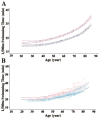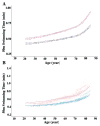Declines in physiological functional capacity with age: a longitudinal study in peak swimming performance
- PMID: 12391125
- PMCID: PMC5063028
- DOI: 10.1152/japplphysiol.00438.2002
Declines in physiological functional capacity with age: a longitudinal study in peak swimming performance
Abstract
We followed up swimming performance times of 321 women and 319 men who participated in the US Masters Swimming Championships over a 12-yr period. All swimmers placed in the top 10 in their age group over 3 yr (mean = 5 yr). A random coefficients model for repeated measures was used to derive a line of best fit from a group of regression lines for each subject. Both 50- and 1,500-m swimming performance declined modestly until approximately 70 yr of age, where a more rapid decline was observed in both men and women. Compared with 1,500-m swimming, the 50-m freestyle declined more modestly and slowly with age. The rate and magnitude of declines in swimming performance with age were greater in women than in men in 50-m freestyle; such sex-related differences were not observed in 1,500-m freestyle. Overall, the variability along a population regression line increased markedly with advancing age. The present longitudinal findings indicate that 1) swimming performance declines progressively until age 70, where the decrease becomes quadratic; 2) the rates of the decline in swimming performance with age are greater in a long-duration than in a short-duration event, suggesting a relatively smaller loss of anaerobic muscular power with age compared with cardiovascular endurance; 3) the age-related rates of decline are greater in women than in men only in a short-duration event; and 4) the variability of the age-related decline in performance increases markedly with advancing age.
Figures



References
-
- American Heart Association. Heart and Stroke: Statistical Update. Dallas, TX: Am. Heart Association; 2000.
-
- Buskirk ER, Hodgson JL. Age and aerobic power: the rate of change in men and women. Fed Proc. 1987;46:1824–1829. - PubMed
-
- Costa PT, McCrae RR. Handbook of Physiology. Aging. chapt. 2. Bethesda, MD: Am. Physiol. Soc; 1995. Design and analysis of aging studies; pp. 25–36. sect. 11.
-
- Costill DL. Inside Running: Basics of Sports Physiology. Indianapolis, IN: Benchmark; 1986.
-
- Craig AB, Pendergast DR. Relationship of stroke rate, distance per stroke, and variation in competitive swimming. Med Sci Sports Exerc. 1979;11:278–283. - PubMed
Publication types
MeSH terms
Grants and funding
LinkOut - more resources
Full Text Sources
Medical

